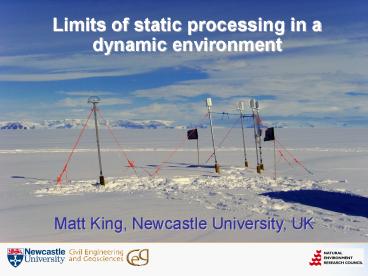Limits of static processing in a dynamic environment - PowerPoint PPT Presentation
Title:
Limits of static processing in a dynamic environment
Description:
... describe the relationship between parameters X and observation ... Period related to satellite pass time? Horizontal Motion Only. Simulation grounded case ... – PowerPoint PPT presentation
Number of Views:25
Avg rating:3.0/5.0
Title: Limits of static processing in a dynamic environment
1
- Limits of static processing in a dynamic
environment
Matt King, Newcastle University, UK
2
Static Processing
- Good for these examples
3
Static Processing
- But what about this?
Detrended
5 min positions
Whillans Ice Stream
4
Background
- Common GPS processing approaches in glaciology
- Kinematic approach
- Antenna assumed moving all the time (although
stop-go possible) - Coordinates at each and every measurement epoch
- Kinematic solutions often difficult due to long
between-site differences - Quasi-static approach
- Antenna assumed stationary for certain periods
(0.5-24h) - 24h common for solid earth
- lt4h common for glaciology
- But is this always valid?
5
GPS Data Processing Approaches
- Quasi-static
- Kinematic
- Quasi-static assumption is that site motion
during each session is averaged out - Note, GAMIT uses the linear motion model in the
lfile, computing position at the epoch level
useful if you know it is linear
0.5-24h
White noise or random walk model
Apriori coordinates file from IGS05_061102.prt
Date Sat Nov 18 173324 EST 2006 VESL_GPS
2009329.76465 -99741.47082 -6033158.41904
0.01046 -0.00167 0.00110 2003.035 0.0008
0.0006 0.0013 0.0002 0.0001 0.0004
6
Motion and Least Squares
- Functional model
- Should fully describe the relationship between
parameters X and observation l with normally
distributed residuals v - F(X)l v
- Stochastic model
- Can attempt to mitigate or account for functional
model deficiencies - Unmodelled (i.e., systematic) errors will
propagate according to the geometry of the
solution - Station-satellite geometry
- Estimated parameters (e.g., undifferenced
Precise Point Positioning solutions vs
double-differenced ambiguity fixed vs ambiguity
float)
7
Systematic Error Propagation
- Estimated parameters
- Station coordinates (X,Y,Z)
- AND real-valued phase ambiguity (N) parameters
- Clock errors differenced out (in double
difference solutions) - Once ambiguities estimated, statistical tests
applied to fix to integers - Fixing not always possible
- Site motion could induce incorrect ambiguity
fixing
8
Real vs ImaginaryExample on the Amery Ice Shelf
GAMIT 1hr quasi-static solutions
Track Kinematic solution
King et al., J Geodesy, 2003
9
Whats happening?
- Presence of motion during static sections
- Violates least-squares principle of normal
residuals - Leads to biased parameter estimates
- Simulation
- How does a 1m/day signal and 1m tidal signal in
1 hr static solutions propagate into the
parameters? - Real broadcast GPS orbits
- Precise Point Positioning approach simulated
- Sites tested at 0S, 45S, 90S
10
Whats happening?
Ambiguity estimates mapped
Latitude
North (m)
Ambiguities fixed
East (m)
Height (m)
Ambiguities not fixed
Satellites East of site
Ambiguity (m)
11
Horizontal Motion Only
- GAMIT 1h solutions over modified zero baseline
Period related to satellite pass time?
0N
90S
12
Horizontal Motion Only
- Simulation grounded case
- How does a 1m/day signal 1 hr static solutions
propagate into the parameters? - Tested 3 flow directions (N, NE, E)
- 1hr solutions
- Site 70S
13
Whats Happening?
Ambiguity estimates mapped
North (m)
Ambiguities fixed
Ambiguities not fixed
East (m)
Height (m)
King et al., J Glac., 2004
14
Whillans Ice Stream
- Based on simulation would expect
- Agreement during stick
- Biases during slip
- But not in kinematic solutions
4hr quasi-static solutions
5min kinematic solutions
15
Conclusions
- Biases may exist in positions on moving ice from
GPS - Up to 40-50 of unmodelled vertical signal
- Up to 10 of unmodelled horizontal signal
- May be offsets, periodic signals or both in east,
north and height components - Height biases of concern when validating Lidar
missions - Periodic signals may result in wrong
interpretation as tidal modulation (or
contaminate real tidal modulation) - To measure bias-free ice motion using GPS
- Fix ambiguities to correct integers (not always
possible) - Use kinematic solution (may require
non-commercial software) - For 24h solutions
- Periodic signals propagate
- Other sub-daily signals (e.g., multipath) need
further study































